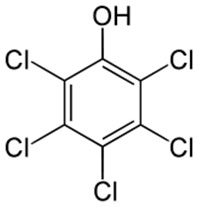 What is Pentachlorophenol?
What is Pentachlorophenol?
Pentachlorophenol is a manufactured chemical that does not occur naturally. Pure pentachlorophenol exists as colorless crystals. Impure pentachlorophenol (the form usually found at hazardous waste sites) is dark gray to brown and exists as dust, beads, or flakes.
Uses
Pentachlorophenol was once one of the most widely used biocides in the United States, but it is now a restricted use pesticide and is no longer available to the general public. The principal use for pentachlorophenol is as a wood preservative; it is also used for the formulation of fungicidal and insecticidal solutions and for incorporation into other pesticide products.
Sources & Potential Exposure
Pentachlorophenol is extremely toxic to humans from acute (short-term) ingestion and inhalation exposure. Acute inhalation exposures in humans have resulted in neurological, blood, and liver effects, and eye irritation. Chronic (long-term) exposure to pentachlorophenol by inhalation in humans has resulted in effects on the respiratory tract, blood, kidney, liver, immune system, eyes, nose, and skin. Human studies are inconclusive regarding pentachlorophenol exposure and reproductive effects. Human studies suggest an association between exposure to pentachlorophenol and cancer.
Oral animal studies have reported increases in liver tumors and two uncommon tumor types. Exposure to pentachlorophenol in the indoor air of pressure-treated log homes brushed with pentachlorophenol has been measured at 0.0005 to 0.01 parts per billion (ppb), and levels in the air of industrially dipped, non-pressure-treated log homes have been measured at 0.034 to 0.0104 ppb. Levels in outdoor air are much lower, and the general population is estimated to breathe in about 0.063 milligrams per day (mg/day).
Workers at wood treatment facilities and lumber mills are estimated to breathe in about 10.5 to 154 mg/ day, and workers who handle treated lumber can absorb about 35 mg/day through the skin. Pentachlorophenol has been detected at low levels in drinking water and food. Exposure may also occur through dermal contact with pentachlorophenol or with wood products treated with pentachlorophenol.
Federal Regulations
EPA has classified pentachlorophenol as a Group B2, probable human carcinogen.

 Americas
Americas Europe
Europe Français
Français Deutsch
Deutsch Italiano
Italiano Español
Español



